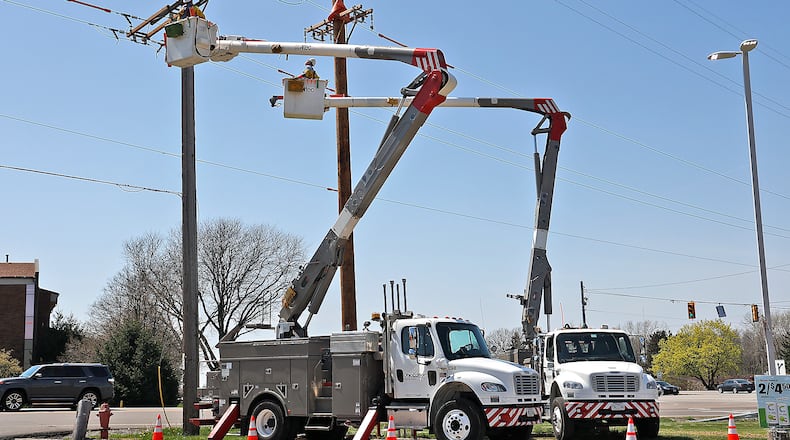Aggregation allows a local government to choose an outside supplier for all residents, and those who do not wish to take part must opt out.
For example, residents in Green, Harmony, Moorefield, Pleasant and Springfield townships are part of the Clark County aggregation program, which won voter approval in 2020.
Residents in those five townships should have received a letter last month explaining they would be switched from Ohio Edison to Dynegy at a rate of 6.378 cents per kilowatt hour (kWh) for electricity used.
That is roughly half of the new rate Ohio Edison announced Wednesday of 12.39 cents/kWh starting June 1, up about 110% from 5.79 cents/kWh now.
“We are happy to create some big-league savings for our customers this year,” said Bob Snavely, energy consultant with Palmer Energy, which represents Clark County’s aggregation program. “We are not promoting this is going to happen again next year.”
Why prices are rising
In Ohio, electric bills are determined by the price for generation supply, and by the price for the transmission and distribution of electricity.
Wholesale standard service auctions determine the generation price.
Snavely said AES Ohio customers in areas such as Montgomery, Miami and Greene counties last year were the first to experience large increases based on the market changes in those auctions. The war in Ukraine, inflation and other factors led to the spike.
First Energy, Duke and “the rest are going to get it now, all the major utilities,” Snavely said. “Aggregation will explode once these prices hit.”
The aggregation market has more flexibility, he said, and at the beginning of this year, experts saw positive signs, including a mild winter.
“We kind of said then, ‘OK, time to go,’ ” he said.
Ohio Edison rate increases will be in effect from June this year until June next year, and “the likelihood is it will then go down,” Snavely said.
The use charges account for part of a monthly bill, and customers can shop for competitive suppliers. Charges to deliver electricity to a home or business and other fees make up the remaining portion, and that is not part of the competitive shopping process.
Competitive suppliers
A release from FirstEnergy, parent of Ohio Edison, said a residential customer using 750 kWh per month can expect to see an increase in their total bill of about 47% from May to June.
“With energy rates elevated as we head into the hot, summer months, now is a great time to review your options so that you can select a rate or program that works best for you and your family,” said Mark Jones, vice president of customer engagement for FirstEnergy. “By selecting a competitive energy supplier that offers a rate lower than the price to compare on your bill, you may be able to pay less each month.”
Ohio Edison serves more than one million customers across 34 Ohio counties, including 57,804 customers in Clark County.
Many of those Clark County customers are in Springfield, where city commissioners have voted to rejoin an aggregation supplier who ceased operating here last year but now plans to resume service in light of Ohio Edison rate hikes.
Springfield rejoins NOPEC
Springfield residents will have the opportunity to join, or rejoin, the Northeast Ohio Public Energy Council (NOPEC) service starting in June.
NOPEC will offer consumers a rate of 6.45 cents per kWh for a six-month period from June to November as the standard program price. Consumers can also opt into a monthly variable price or sign up for a longer fixed term of 12 to 24 months, which guarantees better price predictability.
NOPEC is the largest governmental, nonprofit provider of bulk utility purchasing in Ohio.
City officials this month endorsed the program and accepted a $67,205 grant through NOPEC.
Springfield is one of more than 200 communities in Ohio participating in the program.
City Finance Director Katie Eviston said NOPEC provides consumers savings through bulk purchases of energy.
“Last fall, as you’ll recall, NOPEC returned customer accounts to Ohio Edison due to a dramatic increase in the market price of electricity,” Eviston said.
At the time, Dave Jankowski, chief marketing and communications officer for NOPEC, estimated that approximately 12,700 small businesses and residences in Springfield were affected by the decision.
NOPEC was joined in the decision to suspend aggregation service by an estimated 40 other aggregation organizations as the result of turmoil and skyrocketing prices in the energy market, impacting more than 100,000 Ohioans enrolled in such offerings.
Eviston said NOPEC’s temporary action to return customers to Ohio Edison service resulted in consumers realizing utility savings. She called the temporary suspension of NOPEC very unusual, and she does not expect it to become a regular occurrence.
Springfield residents will receive information about enrollment in the program via mail in the coming weeks.
According to the NOPEC website, all eligible residential and small business accounts within a NOPEC member community such as Springfield are automatically enrolled in NOPEC’s natural gas and/or electric aggregation program. Unless you choose to opt out, you’ll receive utility rates negotiated specifically for NOPEC customers.
If you are new to NOPEC, you may receive a letter from your utility company confirming that NOPEC is your energy supplier. There is nothing you need to do, and there will be no disruption of service. Your utility company will continue to deliver gas and/or electricity service.
Those who do not want to participate in NOPEC’s natural gas or electric program will need to opt out of the service by returning an opt-out form included in the enrollment letter they receive.
Do your research
Snavely and Jankowski both said consumers can accept the county and city aggregation programs or leave them without incurring fees, but they cautioned consumers who are shopping on their own.
Consumers need to do their research, they said.
“Understand the terms, fees and escalation clauses in contracts,” Jankowski said. “Don’t jump at an offer that has a great opening price but changes in 90 days or has a $300 fee to disenroll. Use caution and make an educated decision.”
Jankowski said if Springfield consumers miss the current offering, they can join NOPEC later, but the NOPEC deadline for enrollment of May 2 offers the only guarantee they will avoid the spike in prices anticipated to hit consumers in June.
Jankowski said consumers enrolled in the Standard Service Offer of utility companies this summer could see their bills double.
Bethel, German, Madison, Mad River and Pike townships offer their own aggregation programs, so residents there should contact township officials.
For more information about electric rates and aggregation:
EnergyChoice.Ohio.gov offers comparisons of electric suppliers.
NOPEC, which serves Springfield residents, offers a Customer Care Center at 855-667-3201.
Dynegy, which is the supplier chosen for five Clark County townships, is available at 888-682-2170.
OhioEdison.com is part of First Energy.
Credit: Bill Lackey
Credit: Bill Lackey


